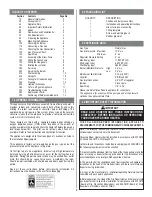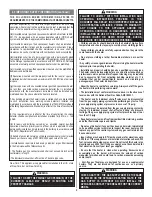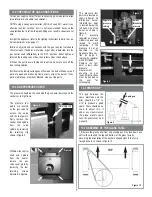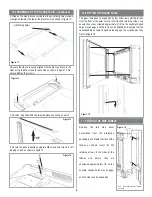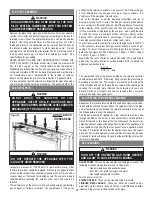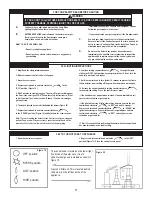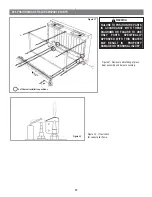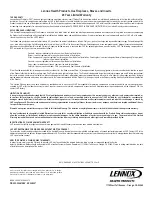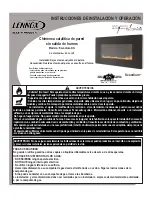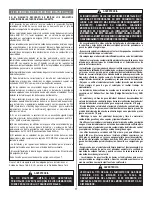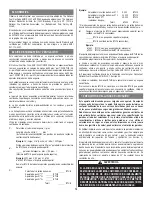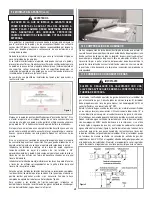
Clearances to non-combustibles
Non-combustible surfaces are defined as brick, metal, marble, concrete
etc. and also a number of man-made materials impervious to flame. If in
doubt refer to the material manufacturer for further information before
proceeding with installation.
Clearances to the sides of the appliance are 4”. Clearance to the front of
the appliance is 20”.
The back of the appliance may be installed directly onto a non-combustible
wall, providing the area behind the appliance is flat and does not interfere
with the various vent holes in the back panel of the appliance.
The appliance may be installed with or without a non-combustible hearth. If
a hearth is fitted, the size and design may be as desired.
A non-combustible shelf of any depth may be positioned above the
appliance provided it is no closer than 16” from the top of the appliance
glass panel and the wall above the appliance is non combustible.
Clearances to combustible materials
Combustible materials are defined as wood, fabrics, or other materials
likely to combust if exposed to flame. Generally, any material, which is likely
to discolour, melt or misshape when exposed to moderate heat, should be
considered as a combustible material or surface.
Clearance to the sides of the appliance are 4” but curtains, drapes and
other fabrics are not permitted within a distance of 20” of the appliance
sides. No such materials are permitted directly above the appliance
regardless of distance.
The minimum clearance to the ceiling above the appliance is 32” measured
from the top of the appliance glass panel.
Combustible materials should not be positioned directly in front of the
appliance within a distance of 40”.
Under no circumstances should any electrical equipment e.g. plasma
screen TV sets etc. be positioned on the wall above the appliance. The
appliance is designed to be wall mounted alone and not in conjunction with
any type of combustible fire surround.
No combustible shelves should be positioned on the wall above the
appliance.
It should be established that any mirrors or picture frames etc. to be
positioned on the wall above the appliance are able to withstand prolonged
exposure to moderate heat and moisture before proceeding with their
installation.
The back of the appliance may be installed directly onto a combustible wall,
providing it is flat and does not interfere with the various vent holes in the
back panel of the appliance. The wall must be structurally sound and
constructed from a material capable of withstanding moderate heat.
Finished plaster, conventional wall paper and dry-lined plasterboard are
examples of suitable materials. Materials such as flock, blown vinyl and
embossed paper which are sensitive to even small amounts of heat should
be avoided as scorching and or discoloration may occur over time.
If the appliance is to be mounted on a dry-lined wall or a timber framed
construction wall then the integrity and ability of the wall to carry the weight
of the appliance must be confirmed. It is important in these circumstances
that any vapor control barrier is not damaged, and that any structural
members of the house frame are not damaged.
The appliance may be positioned as close to a solid floor (i.e. stone,
wooden laminate etc.) as the particular design of fire frame permits,
however it is not permitted to install the appliance within 4” of carpet, rugs
or fabric materials of any kind. This dimension is measured vertically to the
bottom of the appliance frame.
Gas connection :
The heater gas inlet connection is 3/8” NPT at the
regulator, located below the burner, in the center of the heater.
There are four possible
entry points for the gas
supply pipework to enter
the appliance firebox.
These entry points are
‘knock out’ type holes
(shown in figure 1).
Non-concealed gas
connections may be
made using the entry
points on the base of the
firebox. A
concealed
gas connection may be
made using the knock
out hole in the centre
back of the firebox.
Select the most
appropriate entry point and knock out the relevant hole.
If a concealed gas connection is to be made, the supply pipe should always
be sleeved through walls and floors using the shortest possible route.
For concealed supply pipe routing, pipes must (where possible) be vertical
and providing there is sufficient wall thickness available, they should be
placed in pipe chases. Horizontal pipe runs should be avoided where
possible. Prior to chasing a solid wall, an inspection should be made to note
the proximity of any cables/sockets outlets which may already be buried.
Pipes must be secured using suitable clips and protected against corrosion.
Ideally factory finished protected pipework and fittings should be used.
Joints should be kept to a minimum and compression fittings must not be
used. The pipework installation must be tested for soundness before any
protection is applied and/or the pipework and fittings are buried.
After having selected the final mounting position of the appliance, taking
into account the site requirements as specified in section 7 of these
instructions, the integrity of the wall, and the feasibility of the proposed
supply pipe routing, the firebox of appliance may be secured to the wall.
5
7.0 SITE REQUIREMENTS (continued)
8.0 PREPARING THE APPLIANCE
9.0 MOUNTING THE APPLIANCE
Figure 1
DO NOT USE A BLOWER INSERT, HEAT EXCHANGER
INSERT OR OTHER ACCESSORY NOT APPROVED FOR
USE WITH THIS HEATER.
WARNING
DO NOT ALLOW ANY FANS TO BLOW DIRECTLY INTO
THE FIREPLACE. AVOID ANY DRAFTS THAT ALTER
BURNER FLAME PATTERNS.
WARNING


